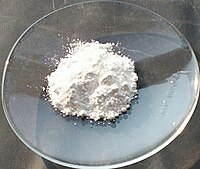
Photo from wikipedia
ZnO films have been prepared by cathodic electrodeposition at room temperature using aqueous and non-aqueous zinc acetate electrolytes with a complexing agent for further application in optoelectronic devices. Influence of… Click to show full abstract
ZnO films have been prepared by cathodic electrodeposition at room temperature using aqueous and non-aqueous zinc acetate electrolytes with a complexing agent for further application in optoelectronic devices. Influence of electrodeposition conditions on homogeneity and continuity of the films is discussed including the role of Trilon B as a complexing agent in grain size decrease and ensure adherence to ITO glass substrates. The annealing temperature has been optimised according to TG-DTA MS and XRD data. All ZnO opals have wurtzite-type structure and morphology of closed-packed round-shaped particles or very thin flakes forming porous sponge-like architecture. ZnO opal films with artificial microporous architecture have been synthesised using a polystyrene opal matrices as templates. Photoluminescence spectra of the ZnO coverages have shown more complex spectra for precipitates sedimented from aqueous baths than from DMSO electrolytes, most likely, because of different characteristic intrinsic defects.
Journal Title: International Journal of Nanotechnology
Year Published: 2019
Link to full text (if available)
Share on Social Media: Sign Up to like & get
recommendations!